
Best Website for Herkimer Diamond Information
Last Updated:

About this Webpage:


Free Website Where Herkimer Diamond Enthusiasts Share Information with the Public
Scroll down
Dr.C. did two talks at the Herkimer Diamond Festival (July)which are in a Youtube movie. The research on the Herkimer District is in need of samples and photos.
How can you help? Visit the "how to help" page.

How Herkimer Diamonds Were Made: A Pictorial Explanation
Dec., 2013

W. David Hoisington, Ph.D.

Art by Dr.C.
Over the decades that man has been collecting these shiny gems of the earth in the Herkimer district people have come up with many explanations as to how they got there. Some of these older explanations are still on the internet and are discussed on the "old theories" web page. This web page presents a new theory - the Oil and Seed Crystal Theory, which is explained in more detail on the theory page. This page presents an overview, displayed in a pictorial representation, of how Herkimer diamonds were formed. This model is supported by laboratory and field evidence.

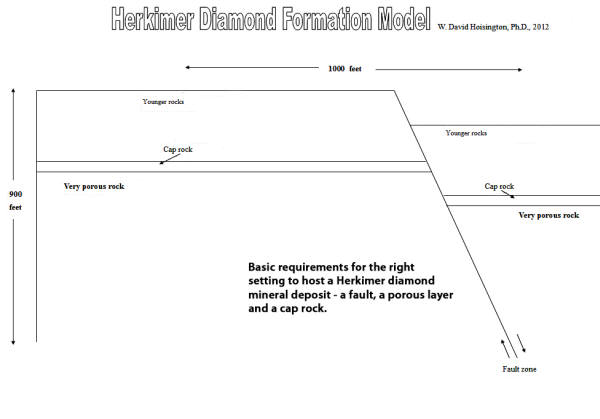


Step 1: Getting the rock ready

Step 2: Fluids follow nature's pathway


Step 3: Fluids make dolomite
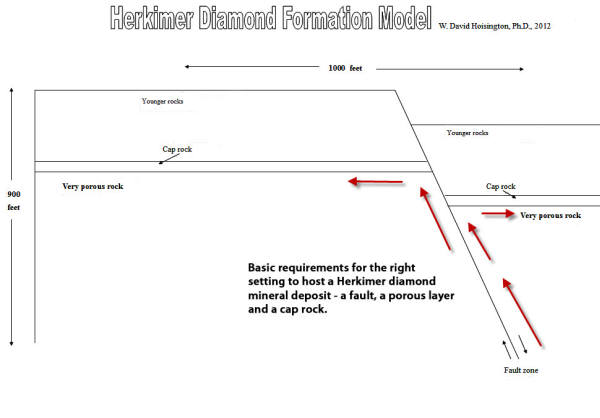
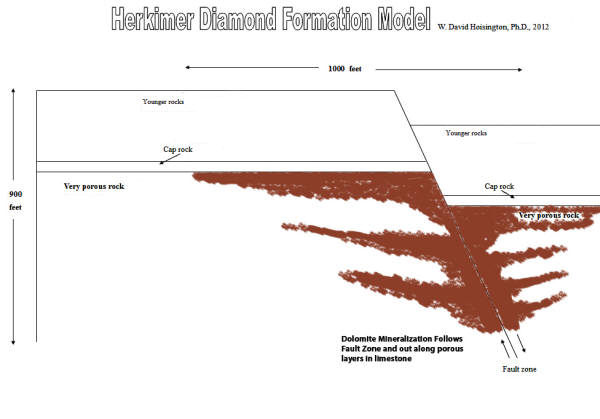


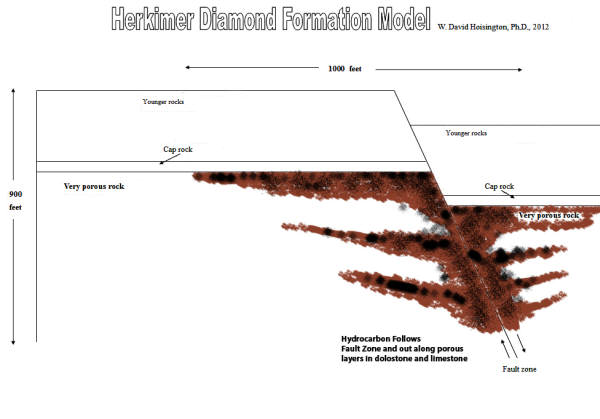

Step 4: Fluids leave hydrocarbons behind

Step 6: Herkimer diamonds grow from the fluids


Step 7: Erosion makes them visable
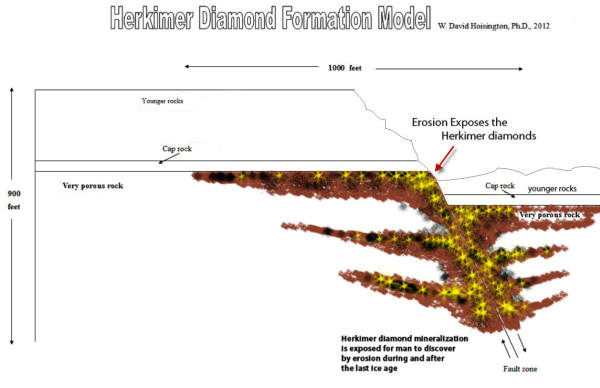
The diagram to the left is a schematic cross section of terrain around a Herkimer mine. This diagram is repeated below with the addition of mineralization episodes. One of the key ingredients which helped to form the Herkimer diamond host rock was the occurrence of porous layers, or layers with holes (B). This is likely the main role of the stromatolites (organisims that made carbonate features similar to coral reefs but made of mounds). See the host rock page for more detail. Over the top of these porous reef-like layers is a more dense cap rock (C) that acted as a barrier. These rocks were then faulted (A) and fractured.
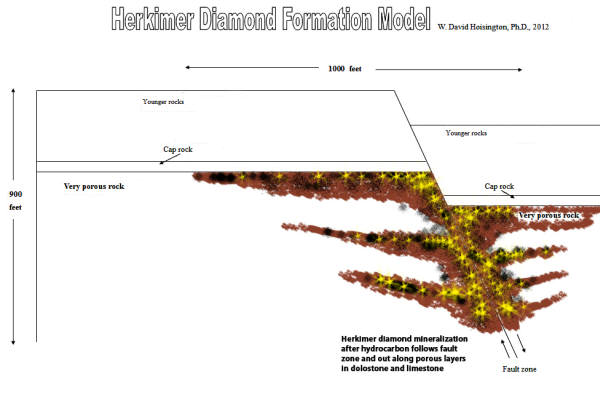
The mineralization in the Herkimer diamond mines was formed from fluids moving up the fractured rock near the fault zones (A) and then out along the porous rocks (B). This means that both vertical and horizontal fluid flow can be responsible for the effects seen in a Herkimer diamond mine. The prominance of either vertical or horizonal flow appears to be one of the factors giving rise to the variations seen across the Herkimer district from one mine to another. The other factor contributing to variation are changes in the General Mineral Sequence from one mine/deposit to another. This is due to variation in the intensity of the fluid effects associated with each stage in the mineral sequence.
On the host rock page is a discussion of weathering. It is important to note that glacial erosion made it possible for man to see the deposits at the surface. Over the past 12,000 years since the glacier, water has been running through the deposits leaving clear and obvious effects. The most notable is the occurrence of smooth walled empty pockets, or mini-caves. Other notable effects include the etching of calcite and dolomite, changing iron sulfides into rust, fracturing Herkimer diamonds (which involves freezing and thawing the water) and the deposition of mud (some of which may be reworked clay of hydrothermal origin).
There is black material at every Herkimer diamond mine/deposit. This material is hardened hydrocarbon, or solidified oil. There are also locations within the Herkimer district that have large amounts of this hydrocarbon and no Herkimer diamonds. The evidence supporting that definition of this black material as fossilized hydrocarbon is presented on the hydrocarbon page and on the quartz sphere page.
The presence of hydrocarbons likely influenced the growth and the color of Herkimer diamonds (see the FAQ page or for more detail see the Science page).
After the seed crystals formed the fluids containing the ingredients to grow the Herkimer diamonds moved through the openings. There is evidence to suggest that these fluid were high in salt content (20%), contained hydrocarbons, and were likely supersaturated with dissolved quartz. We do not find Herkimer diamonds everywhere, even in a given productive zone. There appear to be specific factors governing the places that Herkimer diamonds would grow.
See the Herkimer diamond page for a description of the various types.
The information here is only an overview to the oil and seed crystal theory. Any red text below will provide a link to more detailed information. Click on the red text and it will take you to another page with more detailed information.


Step 5: Hot fluids create "seed crystals"
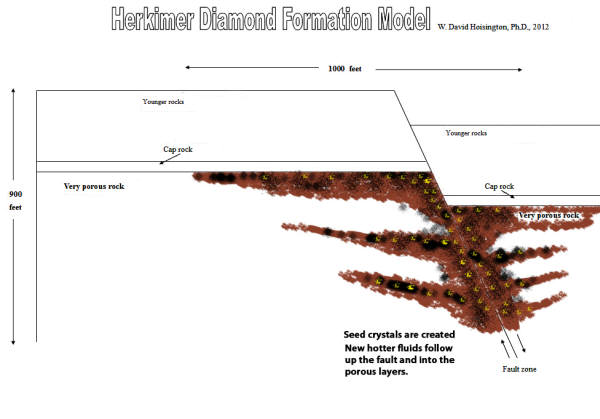
One of the most curious phenomena in the Herkimer diamond mines is the occurrence of tiny "baby" Herkimer diamonds by the handfull in pockets that may also contain larger crystals. It is also common to find "baby" crystals as inclusions inside larger crystals and as a druze coating under larger crystals. The "baby" crystals have even been found floating in a fluid inclusion inside a larger crystal. The conclusion is that there was a baby crystal making episode before the large Herkimer diamonds. This is here called the "seed crystal" episode because it is very likely that these tiny baby crystals acted as seed hosts for growing the larger Herkimer diamonds*.
To see more information on this go to the "baby floater" druze page. Also see the hydrothermal page.


Discussion and Further Research
This explanation for how Herkimer diamonds were made has been the result of many years of field work including the contributions from both mine owners and avid collectors. The oil and seed crystal theory provides the "best fit" explanation to match all of the observations from across the entire Herkimer district.
There are still unanswered questions, for example: How old are Herkimer diamonds? What is the mechanism behind the seed crystal episode? How can Herkimer diamonds form inside a pocket filled with black hydrocarbon? Step contacts between very clear crystals are fairly common, how come we don't see the effect of this inside the crystal (except perhaps with smoky phantoms)? How come we find flat "chip" like tabular fragment inclusions inside Herkimer diamonds, and this is fairly common? Can we describe in more detail the factors that governed where Herkimer diamonds would form in a given mine/deposit? When were the large pocket cavities developed (the original ones that are not smoothed out by post glacial groundwater)? How long did it take to grow a Herkimer diamond? There is also research that needs to be done on each mine/deposit. Each mine has its own mineral sequence (see DA for an example of what this looks like) and each mine is located at a given spot in the larger plumbing system and thus will demonstrate a certain combination of vertical and horizontal flow that is unique to that location. Detailed research in each mine will help to illustrate this.
Finally, there is research that can be done on the nature of a carbonate hosted oil field. The Herkimer district provides an opportunity to see all the features and variations that would otherwise be underground.